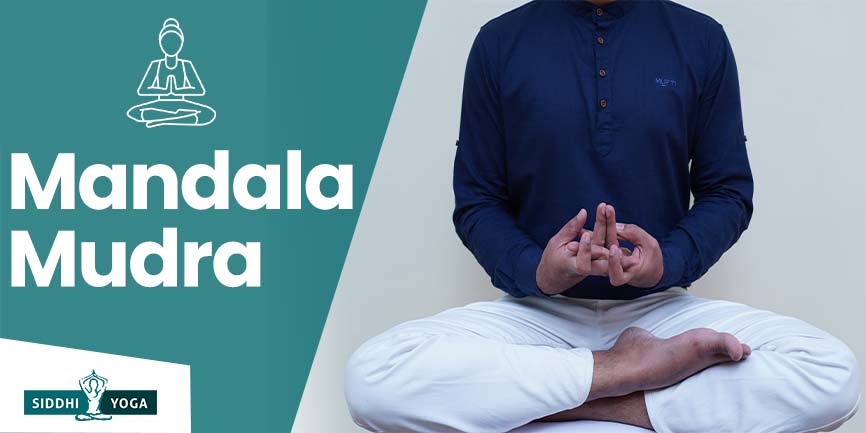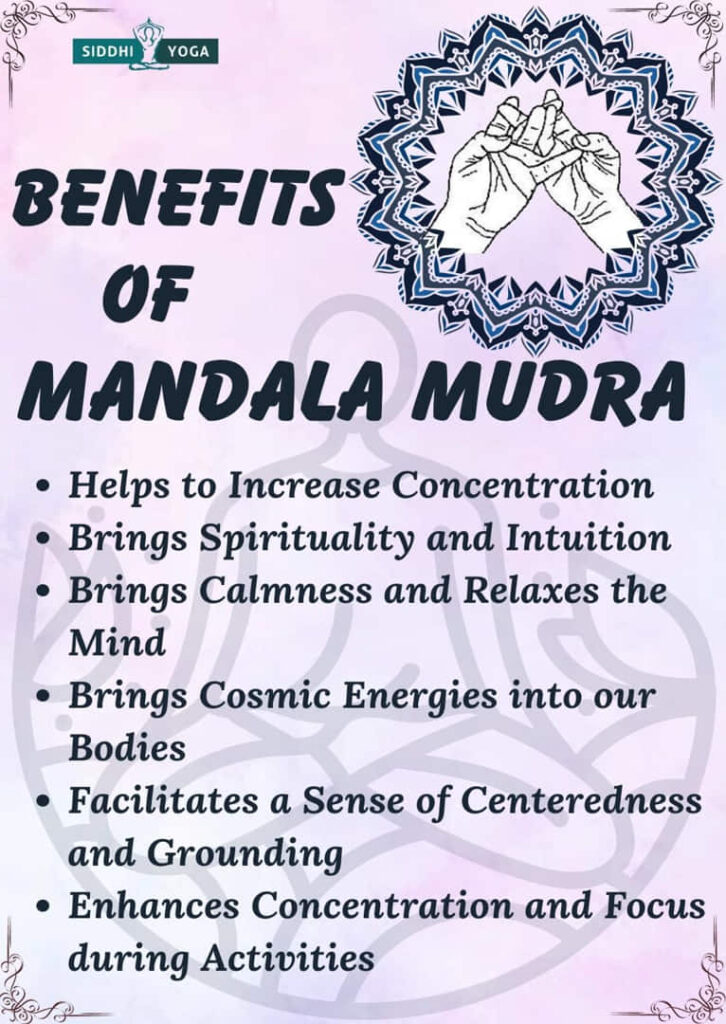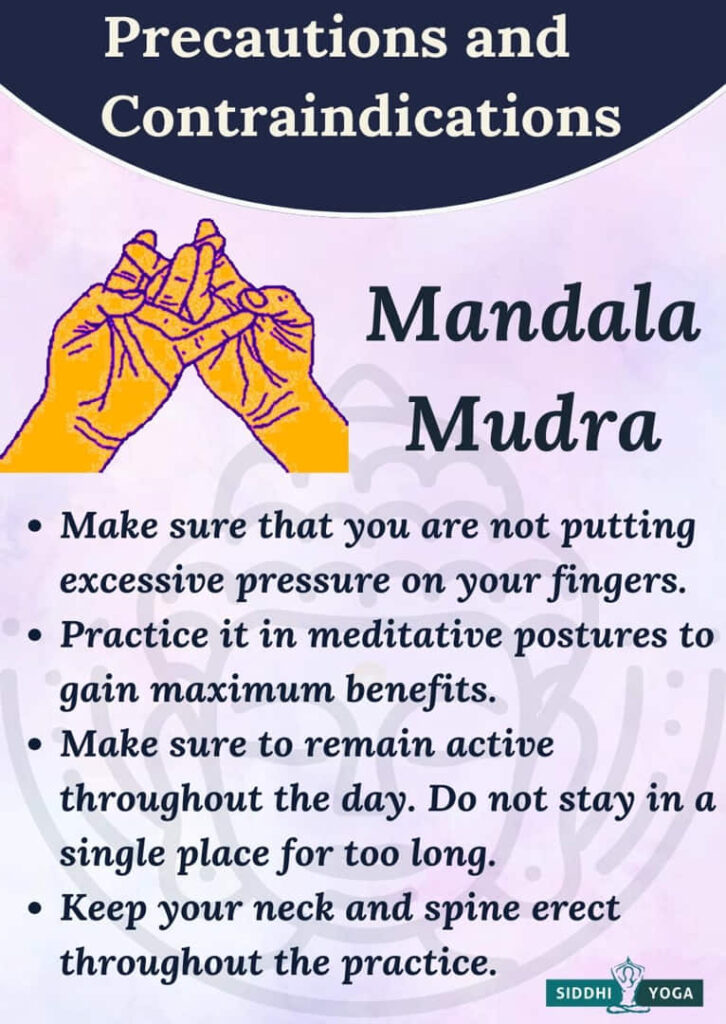Mandala mudra has many benefits, including balancing prana (life force), regulation of the endocrine system, and increased lung capacity and muscle strength.

What is Mandala Mudra? Its Meaning, References and Mythology
Mandala Mudra is one of the Hasta Mudras or hand gestures/seals. The Mandala Mudra is believed to have a Buddhist Origin. The Mandala Mudra is a joint hand gesture or Samyukta Mudra. It is pretty complex. This is one of the Mudras which should be assumed while practicing meditation to attain maximum benefits. Let us simplify its meaning by breaking it down.
Mandala – The word Mandala is of Sanskrit origin, which means the cosmos. The Mandala can also be translated as a geometrical structure, round or circular; these shapes are symbolic of the Hindu and Buddhist religions. It is often observed that if you follow these shapes and sizes for some time, you can experience a sense of calmness.
Mudra – the word Mudra stands for a gesture or seal or lock.
Sometimes Mandala Mudra is also known as Mandala Arpan Mudra. Arpan is a Sanskrit origin word that means to offer or surrender.
Mandala Mudra is also known as a “Gesture of Offering.” However, there are different names, such as “Mandala Offering Gesture” and “Circle Universe Gesture.”
It is believed that practicing this Mudra helps to remove negative thoughts from life. Negative thoughts are the root cause of our suffering. It helps replace negative thoughts with positive ones, as we know that one cannot simultaneously have negative and positive thoughts. Negative thoughts will soon disappear if you learn to keep positive thoughts in your mind.
Mandalas are the geometrical patterns that are believed to be associated with universal energy patterns. Practicing this Mudra is believed to be a way of accepting these energies. The cosmic energies fill us with a more positive approach toward life. Cosmic energy brings intuition and spirituality with itself.
Alternate names of Mandala Mudra
The gesture of Offering, Mandala Arpan Mudra, Circle Universe Gesture, Mandala Offering Gesture
How to Do Mandala Mudra?
- This Mudra does require you to perform while you are seated in any meditative posture, as this Mudra is very complex and requires you to have more attention.
- It is believed that to maximize the benefits of this Mudra, you should practice it during meditation. You can start sitting in Vajrasana (Thunderbolt Posture) or Lotus Posture (Padma Asana).
- Place your hands gently on your knees while your palms should be relaxed and facing upward towards the sky.
- Take a deep breath in and relax completely. Keep your neck and spine upright throughout the practice to avoid aches and pains.
- Now, bring your hands close to each other and intertwine them.
- Then, slowly point your ring fingers upwards.
- Now, slowly join the tip of your thumbs on the base of your little fingers.
- Then, Lock the middle fingers with the opposite index fingers.
- Completely close your eyes.
- Practice deep breathing.
- You can perform this Mudra while practicing different forms of meditation and pranayama.
Benefits of Mandala Mudra

- Mandala Mudra helps to increase concentration.
- This Mudra practice brings spirituality and intuition.
- This Mudra practice is very helpful in getting rid of evil thoughts and emotions. As it replaces negative thoughts and feelings with positive thoughts and feelings.
- It brings calmness and relaxes the mind.
- The upward-pointed ring fingers symbolize Mount Meru, so it is believed that practicing this Mudra brings Meru calmness, stillness, and strength.
- This Mudra practice brings cosmic energies into our bodies.
Precautions and Contraindications of Mandala Mudra

Similar to most of the Hasta Mudras, it has no side effects. However, you can keep a few things into consideration:
- Make sure that you are not putting excessive pressure on your fingers.
- Practice it in meditative postures to gain maximum benefits.
- Make sure to remain active throughout the day. Do not stay in a single place for too long.
- Keep your neck and spine erect throughout the practice.
When and How long to do Mandala Mudra?
- You can practice it if you are looking to follow a spiritual path in your life.
- This Mudra can be practiced if you want calmness, strength, and stillness in your life, just like mount Meru.
- This Mudra can be practiced if you are open to receiving cosmic energies.
- This Mudra can be assumed if you want to increase concentration.
Morning is the ideal time to do any yoga or Mudra. In the morning, at this time during the daytime, our brain is at its best. So, you are more likely to be able to concentrate easily. Therefore, you should practice this Mudra from 4 am and 6 am to get the most effective outcomes.
If you are having difficulty with this during the morning, you can do this Mudra later in the evening too.
Practicing this Mudra for a minimum of 10-20 mins is recommended. Whether you wish to complete it in one stretch or two threes that last between 5 and 10 minutes, it’s up to you. Based on research, the best way to practice an exercise for at least 20 minutes is to get the best benefits of that particular Mudra.
Breathing in Mandala Mudra
To enhance your practice, you can practice breathing techniques with this Mudra.
- Diaphragmic breathing: When you inhale, let the belly come out and relax comfortably when you exhale.
Visualization in Mandala Mudra
Visualize that you are standing in front of Mount Meru. You are offering your obeisance to Mount Meru. While Bowing forward, Keep an intention of surrender.
Affirmation of Mandala Mudra
While practicing this, Keep a positive intention. Start with: I believe in divinity. I think that I’m a tiny part of the cosmos or Mandala.
Conclusion
The Mandala Mudra is a gesture that can be used to represent the universe. It is said to have many benefits, including improved mental clarity and focus, increased creativity, and better sleep. Anyone can practice this mudra. If you are interested in learning more about this mudra and how to practice it, we offer a Mudra Certification Course that will teach you everything you need to know. In addition, 108 different mudras are covered in the course so that you can find the perfect one for you.